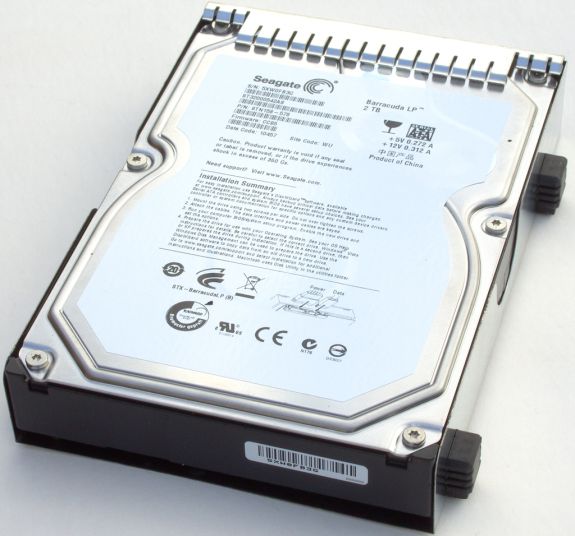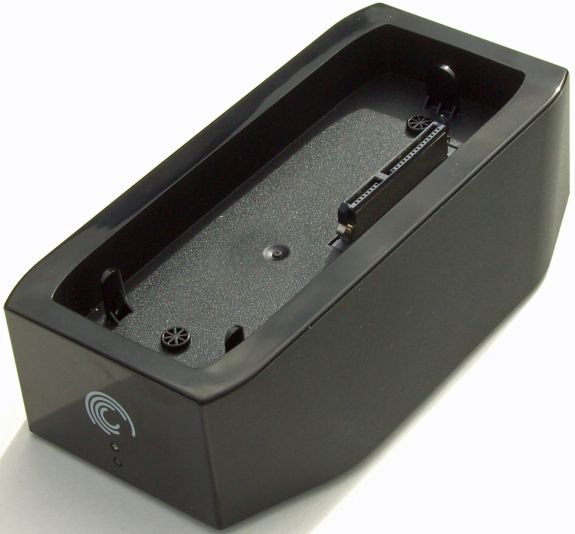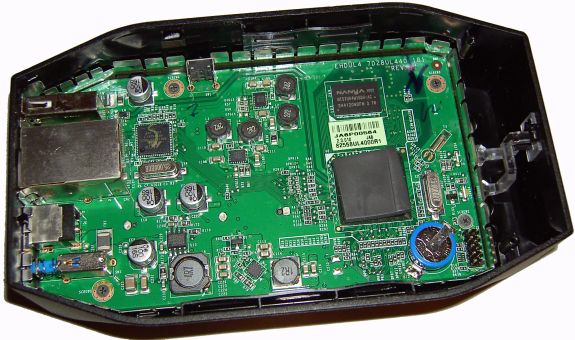Seagate GoFlex Home 2TB Reviewed
by Rajinder Gill on October 10, 2010 5:05 PM ESTAlong with the 3TB Seagate USB drive Anand reviewed last month, Seagate also sent us a NAS drive based around the same aesthetics – the GoFlex Home 2TB:

The 2TB GoFlex Home
The GoFlex Home connects via a Gigabit Ethernet port and allows all manner of media streaming, file sharing and backups across a home network or the internet with the key emphasis of Seagate's software bundle being on ease of use. 2TB of space is more than enough space to store a huge library of video and music, and more than ample to be used as a general backup device. The 2TB GoFlex Home retails around $229 - if you can’t see yourself needing that much storage, Seagate offers a 1TB version of Go priced around the $159 mark.
Let's delve staright down into the physcial stuff before we take a gander at the software package...
As with the 3TB GoFlex Desk, we managed to force the casing apart and take a peak at the drive inside:

It's a Seagate Barracuda ST32000542AS
Seagate's choice of casing was a stifling blow for the 3TB GoFlex Desk. Hopefully we won't find the same problems on the 2TB Home - we'll be taking a look at temps a little later.

The GoFlex Home docking station
Upgrading or replacing a drive at a later date is possible, although you are limited to using one of Seagate's GoFlex drives. A couple of LEDs grace the front side of the docking unit; one pertaining to connectivity and the other showing drive ready status (drive activity is not shown, unfortuantely). Although we haven't pictured the rear here, a gigabit ethernet port, USB port (for plugging in a network printer or USB drive), on/off switch and power input connectors are all located on the rear of the unit. Power is supplied by a (included) wal-wart 12V PSU.
At the heart of the Go FLexHome is a 1.2GHz Marvell 88F6281 processor (underneath the tthermal pad), teamed up with 128MB of Nanya RAM and also 500MB of flash memory. The Gigabit Ethernet port is driven by a Marvell 88E116R LAN controller.











30 Comments
View All Comments
brucek2 - Sunday, October 10, 2010 - link
They mention later on that there's a GigEthernet port as well.Voldenuit - Monday, October 11, 2010 - link
WTF. Seriously?A NAS that uses a proprietary drive mounting system, charges a subscription fee to give you unlimited account access and is crippled by writes?
You could/should have completed the review with just two words: 'IT's CRAP' and tossed the damn thing into a trashcan.
I imagine something like a Synology NAS would have this thing licked in terms of features, performance and upgradability (hont: would love to see a proper review of a Synology NAS to compare). Recommending the GoFlex for *any* user (especially what amounts to uninformed general users) with little or no comparison to the rest of the market seems irresponsible to me.
Voldenuit - Monday, October 11, 2010 - link
*hint, not hont.dia - Monday, October 11, 2010 - link
If it were as bad as you imply, Small Network Builder would have arrived at a different conclusion, too. I think given the type of user this drive is aimed at it's not bad overall.http://www.smallnetbuilder.com/nas/nas-reviews/312...
HMTK - Monday, October 11, 2010 - link
You can't compare this to a Synology on features nor price.Voldenuit - Monday, October 11, 2010 - link
A Synology DS210 is $200 (bare unit) and has 2 drive bays, DLNA, RAID and bittorent functionality. The type of user who needs a NAS will probably have spare hard drives lying around and/or would appreciate not being locked into a vendor-specific configuration. Anyone who puts a 2 TB drive in a NAS probably won't appreciate slow write speeds, either.If the Synology performs to expectations (hint: review pls), it would represent much better value and be a better technical solution than the Seagate.
PS Did AT test performance under multi-client access? After all, the point of a NAS is to serve multiple users on a single network.
Duftopia - Sunday, September 14, 2014 - link
I would have agreed with you when I bought the unit. Seagate on the other hand does make A++ Hard drives which is what they are good at, they DO NOT write A++ software, nor have exceptional support (as of 2013).the $9.99 subscription was in my opinion a travesty, NO professional company like Seagate should resort to such a money grab, but after several years of use I must say the drive is an exceptional and cheap backup and streaming device (although almost always behaves as-if its on its last leg).
Duf
baba264 - Tuesday, October 12, 2010 - link
I'd be quite interested by reading reviews of other NAS units as I might be interested in buying one in the not so distant future (6 month or so).I would be interested to see what higher priced solutions have to offer and would particularly like to read about solutions that would allow RAID 5. As was said before, with these kind of solutions, it is nice to have some kind of insurance against drive failure.
Rajinder Gill - Tuesday, October 12, 2010 - link
Hi,We'll try and get some more stuff in to review - specifically enclosures offering redundancy. This is our first NAS review so there's room for improvement and we're taking all suggestions into consideration for future articles.
-Raja
Voldenuit - Tuesday, October 12, 2010 - link
Thanks Raja!Looking forward to more reviews from AT on NASes as they become more relevant to home users. Maybe even find some way to put them on Bench? ^_~ Things that I can think of offhand that would be good to know before spending $200+ on a NAS:
1. Performance under different connection protocols (100/1000/801.11n)
2. Read and write (and concurrent r+w) speeds
3. Performance scaling with multiple queues/users
4. Setup and installation
5. Compatibility with various client OSes and HDDs (Advanced format, 2 TB+ etc)
6. Administrative access
7. Features and utilities (usb printer server, http/ftp host, BT, RAID, QoS)
8. Streaming features and compatibility (xbmc, DLNA, Boxee etc etc)
9. Power, heat and noise (some NASes have tiny whirring fans, others resonate HDD noise)
You covered quite a few of these in your review, obviously the GoFlex is a very basic device compared to its peers in terms of features.
It might be interesting to set up a baseline system to compare NAS performance with a cheap DIY server like a miniITX Atom server running Linux/Windows. Especially when Bobcat trickles in.
I'm sure more suggestions will trickle in, so let me say thank you again for taking on this monumental task ;).